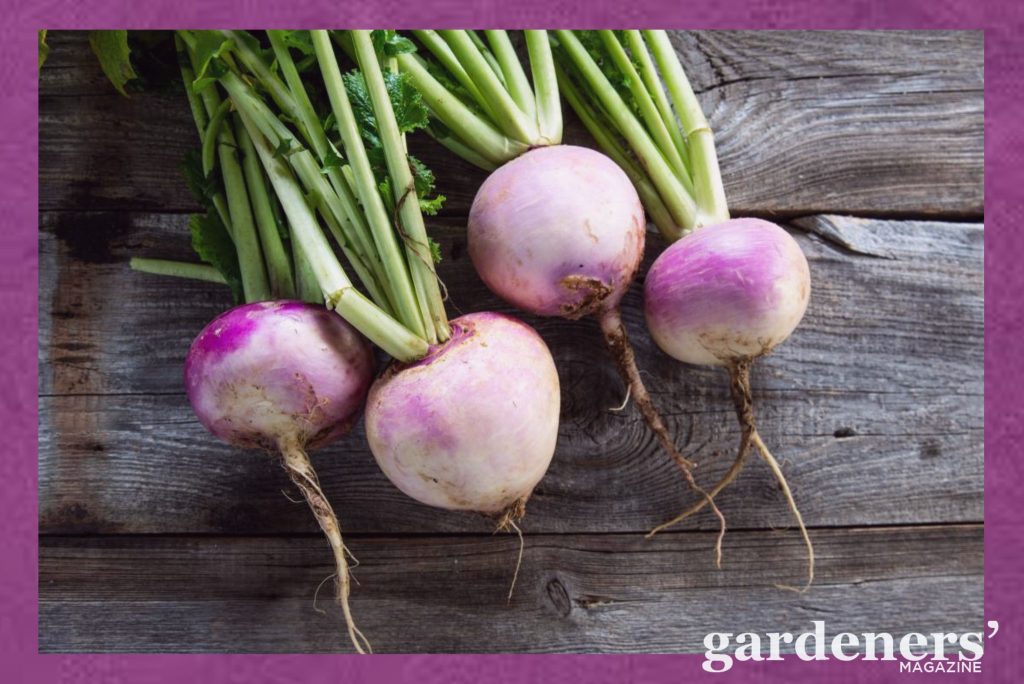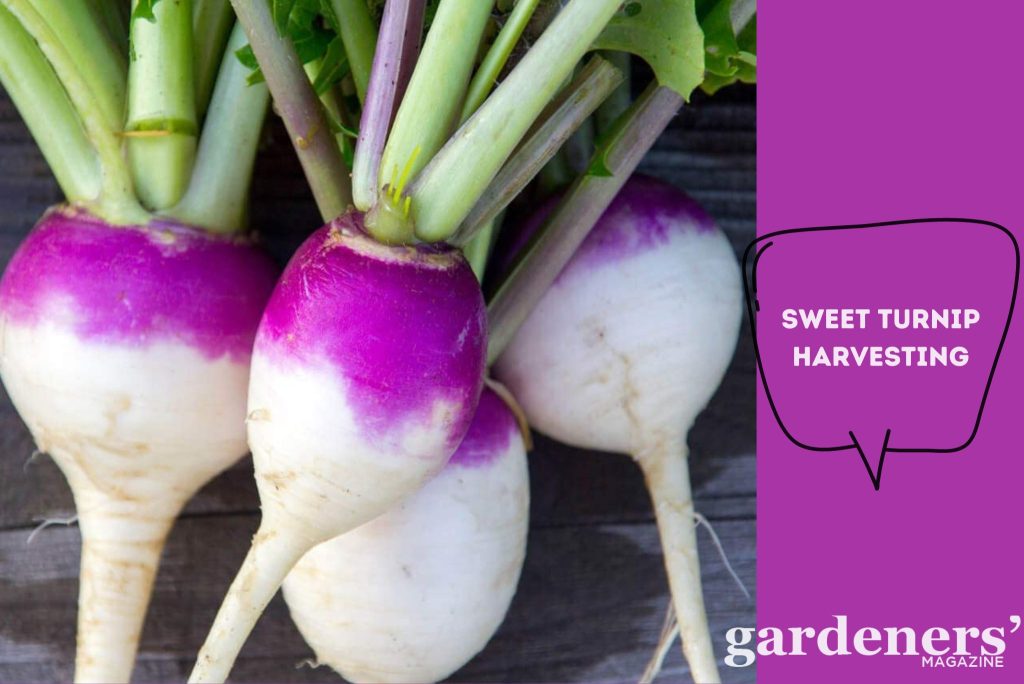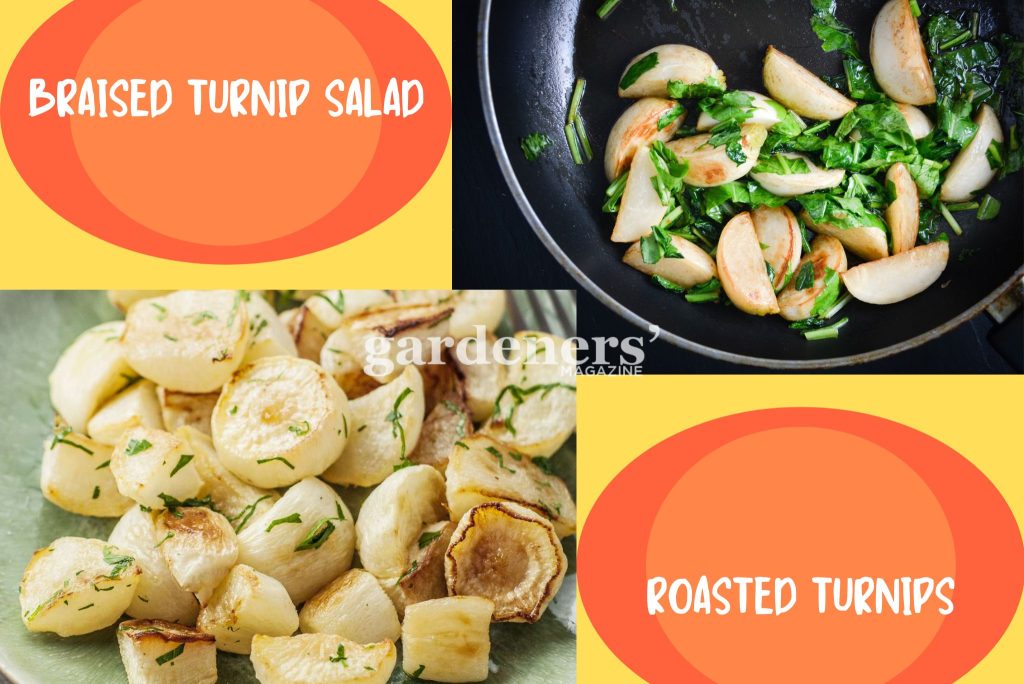Sweet turnip, scientifically known as Brassica rapa var. rapa, is a root vegetable with a sweet and crunchy texture when cooked. This versatile root vegetable, also referred to as “Hakurei turnip” or “Japanese turnip,” boasts a delicate flavor profile and crisp, tender texture.
Unlike traditional turnips, Sweet Turnips are prized for their mild, sweet taste, making them a delightful addition to salads, stir-fries, and soups. With their quick growing cycle and ability to thrive in various climates, Sweet Turnips are a favorite among gardeners and farmers alike. Whether grown in home gardens or cultivated on a larger scale, Sweet Turnips offers a delicious and nutritious addition to any culinary repertoire.

What is a Sweet Turnip?
Sweet turnip is a root vegetable from the Brassica family. It has edible, white-colored roots and dark green leaves. Depending on its maturity, sweet turnip’s flavor can range from sweet to slightly bitter. When cooked, it has a crisp texture with a slightly sweet aftertaste.
In contrast to traditional turnips, Sweet Turnips are harvested at a young and tender stage, avoiding the development of a strong, pungent flavor. They typically exhibit a round or cylindrical shape, boasting smooth, white skin and creamy flesh. Renowned for their versatility, Sweet Turnips lend themselves well to raw consumption in salads, pickling, or light cooking in stir-fries and soups.
Due to their rapid growth cycle and ability to thrive in various climates, Sweet Turnips have gained popularity among both home gardeners and farmers. Their cultivation is relatively straightforward, and they offer a delightful sweetness to culinary creations while imparting essential vitamins, minerals, and dietary fiber to the diet.
History and Origin of the Sweet Turnip
The history and origin of the Sweet Turnip can be traced back to Japan. These turnips have been cultivated for centuries in Japanese agriculture, where they are highly esteemed for their delicate flavor and tender texture. Historically, Sweet Turnips were grown in Japan and used in a variety of dishes, from salads to pickles.
Over time, their popularity has spread to other parts of the world, including North America and Europe, where home gardeners and commercial farmers alike now cultivate them. Today, Sweet Turnips are enjoyed globally for their unique taste and culinary versatility, contributing to their continued cultivation and popularity in modern agriculture.
The sweet turnip is a member of the Brassica family and is related to broccoli, kale, and cauliflower. It is an edible root vegetable that can range from white to yellow. Sweet turnips are typically harvested when flavor peaks in late summer or early autumn.

Health Benefits of the Sweet Turnip
Due to their rich nutritional profile, sweet turnips offer numerous health benefits. They are low in calories yet high in essential nutrients such as vitamin C, vitamin K, and folate, which support immune function, blood clotting, and cell growth. Additionally, sweet turnips are a good source of dietary fiber, which promotes digestion, regular bowel movements, and satiety.
They also contain antioxidants like beta-carotene and vitamin C, which protect cells from damage and may lower the risk of chronic diseases like heart disease and cancer. Compounds found in turnips, such as glucosinolates, may have anti-inflammatory properties, potentially reducing inflammation and the risk of conditions like arthritis.
Moreover, the fiber, potassium, and folate in sweet turnips support heart health and blood sugar regulation, making them a valuable addition to a healthy diet.
Where are Sweet Turnips Grown and Harvested?
They are primarily grown and harvested in regions with temperate climates conducive to root vegetable cultivation. Historically originating in Japan, they are still widely cultivated in Japanese agriculture, particularly in regions like Hokkaido, Nagano, and Kyoto. However, sweet turnips are also grown in other parts of Asia, including South Korea and China.
Outside of Asia, sweet turnips are increasingly cultivated in North America and Europe. In the United States, they are grown in various states with suitable growing conditions, such as California, Washington, and Vermont. In Europe, countries like France, Italy, and the United Kingdom also cultivate sweet turnips, often in smaller-scale organic farms and garden plots.

Flavor Profile of the Sweet Turnip
The sweet turnip’s flavor profile is characterized by its delicate, mildly sweet taste and tender texture. Unlike traditional turnips, which can have a stronger, more pungent flavor, sweet turnips are prized for their subtle sweetness and lack of bitterness or harshness. Their crisp, juicy flesh offers a refreshing crunch when eaten raw, making them ideal for fresh salads or vegetable platters.
The sweet turnip has a subtle, mild flavor that is slightly sweet and nutty. It has a tender texture and a hint of earthiness. The sweetness in the turnip can be enhanced by roasting it or adding butter and herbs such as rosemary, sage, thyme, or chives. When cooked, the sweetness intensifies, and the turnip is creamy.
Overall, sweet turnips’ flavor profile is mild, slightly sweet, and versatile, making them a favorite ingredient in both raw and cooked culinary applications.
Where to Find the Best Quality Sweet Turnip?
Top-notch sweet turnips are commonly discovered at farmers’ markets, specialty grocery stores, and local farm stands, where an emphasis is placed on freshness and excellence. Opting for organic or locally sourced produce can elevate the chances of encountering premium sweet turnips, as these are typically cultivated with meticulous care and a focus on flavor. Many small-scale farmers and organic growers prioritize soil health and sustainable farming practices, leading to the production of flavorful and nutritious crops.
In essence, superior-quality sweet turnips are frequently obtained from producers who prioritize taste, freshness, and sustainability in their cultivation endeavors.
How to Store Sweet Turnips?
To preserve sweet turnips, remove any green tops, as they can leach moisture from the roots. Then, loosely wrap them in a paper towel or place them in a ventilated plastic bag to maintain moisture levels. Optimal storage is in the refrigerator’s vegetable crisper drawer, where temperatures are stable but slightly warmer.
Avoid proximity to ethylene-producing fruits, as sweet turnips are sensitive to this gas. Given their preference for high humidity, ensure they are stored in a cool, humid environment to prevent dehydration. Regularly inspect them for signs of spoilage and promptly discard any damaged turnips. With proper care, sweet turnips can maintain freshness and flavor over an extended period.
For shorter-term storage, the crisper drawer of the refrigerator suffices. Before cooking, thoroughly wash the sweet turnips to remove any dirt or debris.
How to Use Sweet Turnip in Recipes?
Here are some ideas for how to use sweet turnips in recipes:
- Sauté cubes of sweet turnips with onions and garlic as an accompaniment to fish or poultry dishes.
- Make a flavorful stir-fry with cubes of sweet turnips, garlic, ginger, soy sauce, and other vegetables.
- Make an oven-roasted vegetable dish with sweet turnips, carrots, potatoes, onions, and garlic cubes.

Conclusion
In conclusion, sweet turnip is a nutritious vegetable with many health benefits. It can be grown and harvested in many different regions around the world during certain times of the year. The flavor profile of the sweet turnip is subtle and mild, with a slight sweetness and nutty taste. The best place to find high-quality sweet turnips is at your local farmers’ market, and they should be stored in the refrigerator or a cool, dark place like a root cellar. Sweet turnips can be used in many recipes, such as stir-fries, roasted vegetable dishes, and more. Overall, sweet turnip is an excellent addition to any meal!
- Everything You Wanted to Know About Red Tamarillos - June 2, 2025
- A Guide to Tulips: Everything You Need to Know & More… - June 2, 2025
- Guanabana: Description, Flavor, Benefits, And Uses - May 27, 2025
